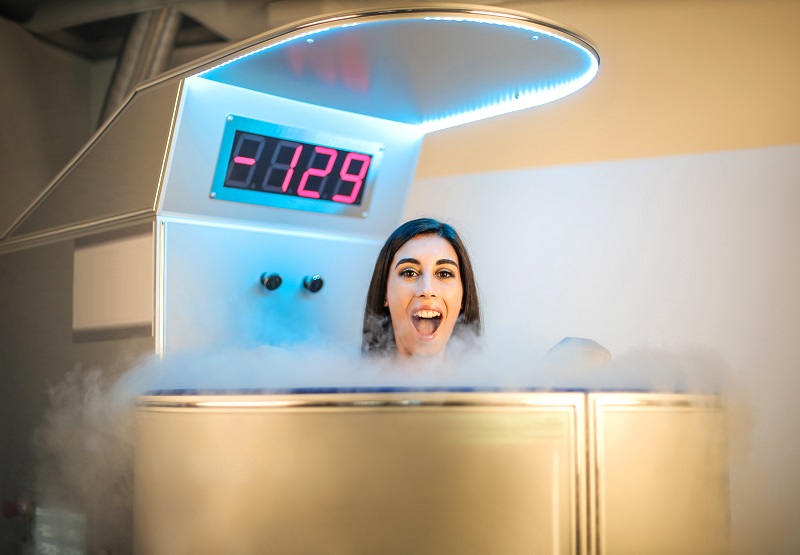Exposing the body to cold temperatures may feel uncomfortable, but studies show it provides numerous health benefits. The cold constricts blood vessels and slows down blood flow, relieving pain and helping the body heal faster after injury or stress.
Ice baths are a popular method of recovering after an injury, especially in sports. In recent years, people have been embracing another cold therapy method called cryotherapy.
So, how does cryotherapy differ from an ice bath?
In this article, we discuss their key differences, as well as the pros and cons of each method.

Cryotherapy vs. Ice Bath: What Is the Difference?
The main differences between cryotherapy and an ice bath are their safety profile and the benefits they provide.
| Cryotherapy | Ice Bath | |
|---|---|---|
| The procedure | The patient is enclosed in a cryotherapy chamber that emits cold air which stimulates the body’s natural healing processes. | The patient is submerged in cold water which stimulates the body’s natural healing processes. |
| Temperatures used | Below -212°F | 50°F to 60°F |
| Duration | 3 minutes | 10—20 minutes |
| Risks and side effects | Side effects: Discomfort due to extreme cold, numbness, increased blood pressure, tingling, redness. Risks: Impaired breathing. | Side effects: Discomfort due to extreme cold, numbness, increased blood pressure, tingling, redness. Risks: Hypothermia, cardiac arrest. |
| Benefits | Reduces muscle soreness and pain Decreases inflammation after injury Speeds up recovery after injury Reduces stress Improves skin tone and texture Reduces signs of aging Helps with weight loss Improves the mood | Reduces muscle soreness and pain Decreases inflammation after injury Speeds up recovery after injury Reduces stress |
Benefits
One of the main benefits of cryotherapy and ice baths is reduced healing time after a sports injury.
The cold causes blood vessels to constrict. After the session, the blood vessels expand, helping to flush out toxins and reduce inflammation.
Cryotherapy provides additional benefits:
- Increased collagen production
- Faster cell turnover
- Tighter skin
- Faster calorie burn, aiding in weight loss
- Increased adrenaline and endorphin levels, enhancing the mood
Time
There isn’t a consensus on the ideal duration of ice baths. They typically last 10 to 20 minutes. Spending more than 20 minutes in freezing water may lead to frostbite.
A cryotherapy session takes 3 minutes and is performed in a controlled environment with a medical provider who supervises the procedure.
Equipment
The equipment used for an ice bath is a tub (at home or the gym), cold water, and ice.
Cryotherapy is performed in a cryotherapy chamber in a medical clinic or med spa.
Flexibility
Ice baths work best if performed two hours after a workout session.
For sports practitioners, cryotherapy is effective before and after workout. To achieve its other benefits (anti-aging, mood-enhancing, etc.), the treatment can be effectively performed at any time.
Temperature
For best results, the temperature of an ice bath ranges between 50°F and 60°F. At this temperature, water penetrates the skin, causing an uncomfortable freezing sensation.
The temperature of the air emitted in a cryotherapy chamber is below -212°F. However, due to its dryness, the cold air causes less discomfort than ice baths.
Effectiveness
Ice baths and cryotherapy are equally effective at relieving muscle pain or providing a subjective feeling of pain relief.
However, cryotherapy is a more effective treatment for general health because it provides a broader range of benefits.
Safety
Ice baths carry more risk than cryotherapy because athletes often perform them unsupervised. High blood pressure, uncontrolled diabetes, or other health conditions combined with an ice bath may result in heart complications. Spending more than 20 minutes in freezing water may lead to frostbite.
Cryotherapy is performed in a controlled environment with a medical provider who supervises the procedure and modifies the temperature according to the body’s reactions.
Side Effects
Common cryotherapy and ice bath side effects include:
- Discomfort due to freezing temperatures
- Tingling
- Redness
- Numbness
- Increased blood pressure
With ice baths, patients also face the risk of hypothermia and cardiac arrest.
Note: Impaired breathing is a very rare side effect of cryotherapy. It doesn’t pose a serious threat and is quickly mitigated by the medical provider who controls and adjusts oxygen levels during the procedure.
Cryotherapy vs. Ice Bath: Which One Is Better?
Cryotherapy and ice baths effectively decrease soreness, pain, and inflammation after a sports injury. However, cryotherapy involves less risk, lasts only three minutes, and provides other health and beauty benefits.
Conclusion
Patient experiences and some studies show that cold therapy treatments like ice baths and cryotherapy significantly decrease muscle pain and reduce stress. To achieve these effects, opt for cryotherapy, which is both the safer method and can also provide additional benefits.


